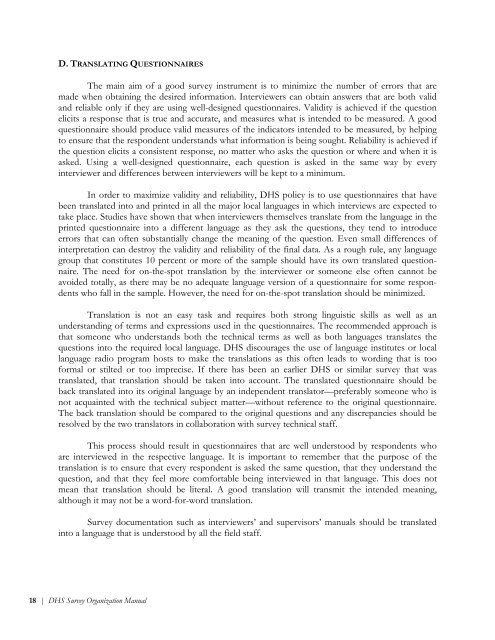DHS6_Survey_Org_Manual_7Dec2012_DHSM10 ... - Measure DHS
DHS6_Survey_Org_Manual_7Dec2012_DHSM10 ... - Measure DHS
DHS6_Survey_Org_Manual_7Dec2012_DHSM10 ... - Measure DHS
You also want an ePaper? Increase the reach of your titles
YUMPU automatically turns print PDFs into web optimized ePapers that Google loves.
D. TRANSLATING QUESTIONNAIRES<br />
The main aim of a good survey instrument is to minimize the number of errors that are<br />
made when obtaining the desired information. Interviewers can obtain answers that are both valid<br />
and reliable only if they are using well-designed questionnaires. Validity is achieved if the question<br />
elicits a response that is true and accurate, and measures what is intended to be measured. A good<br />
questionnaire should produce valid measures of the indicators intended to be measured, by helping<br />
to ensure that the respondent understands what information is being sought. Reliability is achieved if<br />
the question elicits a consistent response, no matter who asks the question or where and when it is<br />
asked. Using a well-designed questionnaire, each question is asked in the same way by every<br />
interviewer and differences between interviewers will be kept to a minimum.<br />
In order to maximize validity and reliability, <strong>DHS</strong> policy is to use questionnaires that have<br />
been translated into and printed in all the major local languages in which interviews are expected to<br />
take place. Studies have shown that when interviewers themselves translate from the language in the<br />
printed questionnaire into a different language as they ask the questions, they tend to introduce<br />
errors that can often substantially change the meaning of the question. Even small differences of<br />
interpretation can destroy the validity and reliability of the final data. As a rough rule, any language<br />
group that constitutes 10 percent or more of the sample should have its own translated questionnaire.<br />
The need for on-the-spot translation by the interviewer or someone else often cannot be<br />
avoided totally, as there may be no adequate language version of a questionnaire for some respondents<br />
who fall in the sample. However, the need for on-the-spot translation should be minimized.<br />
Translation is not an easy task and requires both strong linguistic skills as well as an<br />
understanding of terms and expressions used in the questionnaires. The recommended approach is<br />
that someone who understands both the technical terms as well as both languages translates the<br />
questions into the required local language. <strong>DHS</strong> discourages the use of language institutes or local<br />
language radio program hosts to make the translations as this often leads to wording that is too<br />
formal or stilted or too imprecise. If there has been an earlier <strong>DHS</strong> or similar survey that was<br />
translated, that translation should be taken into account. The translated questionnaire should be<br />
back translated into its original language by an independent translator—preferably someone who is<br />
not acquainted with the technical subject matter—without reference to the original questionnaire.<br />
The back translation should be compared to the original questions and any discrepancies should be<br />
resolved by the two translators in collaboration with survey technical staff.<br />
This process should result in questionnaires that are well understood by respondents who<br />
are interviewed in the respective language. It is important to remember that the purpose of the<br />
translation is to ensure that every respondent is asked the same question, that they understand the<br />
question, and that they feel more comfortable being interviewed in that language. This does not<br />
mean that translation should be literal. A good translation will transmit the intended meaning,<br />
although it may not be a word-for-word translation.<br />
<strong>Survey</strong> documentation such as interviewers’ and supervisors’ manuals should be translated<br />
into a language that is understood by all the field staff.<br />
18 | <strong>DHS</strong> <strong>Survey</strong> <strong>Org</strong>anization <strong>Manual</strong>








![Obtaining Informed Consent for HIV Testing [QRS4] - Measure DHS](https://img.yumpu.com/49850117/1/190x245/obtaining-informed-consent-for-hiv-testing-qrs4-measure-dhs.jpg?quality=85)








